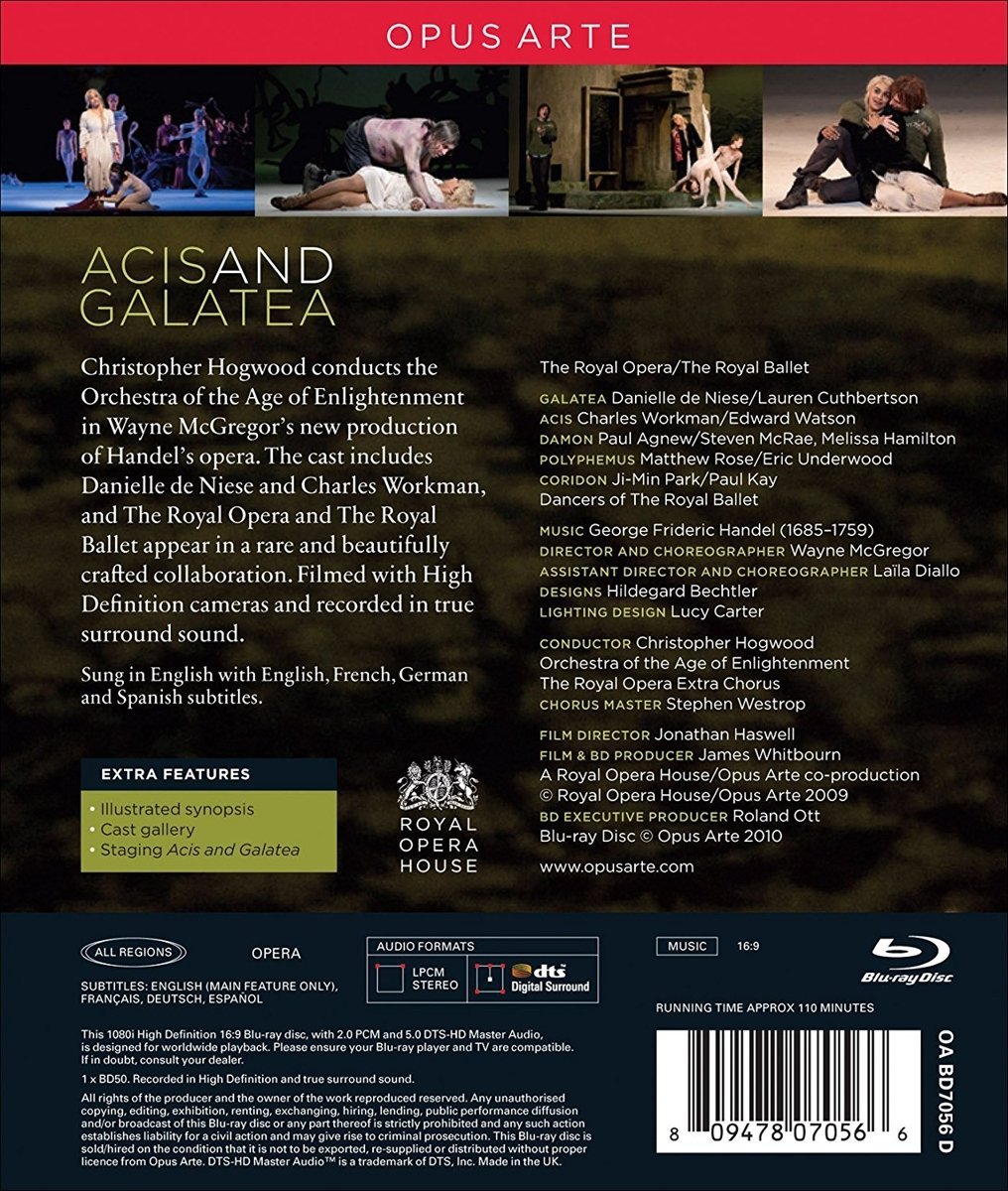

Handel Acis and Galatea opera to libretto by John Gay, Alexander Pope, and John Hughes. Directed 2009 by Wayne McGregor (assistant Laïla Diallo) at the Royal Opera House. The singing stars are Danielle de Niese (Galatea, a Nymph), Charles Workman (Acis, a Shepherd), Paul Agnew (Damon, a Shepherd), Matthew Rose (Polyphemus), Ji-Min Park (Coridon, a Shepherd), Juliet Schiemann (Chorus Soprano Soloist), and Phillip Bell (Chorus Tenor Soloist). The dancing stars from the Royal Ballet are Lauren Cuthbertson (Galatea), Edward Watson (Acis), Steven McRae (Damon), Melissa Hamilton (Damon), Eric Underwood (Polyphemus), and Paul Kay (Coridon). Other dancers are Olivia Cowley, Cindy Jourdain, Kristen McNally, Iohna Loots, Samantha Raine, Brian Maloney, Liam Scarlett, Johannes Stepanek, and Dawid Trzensimiech. Christopher Hogwood conducts the Orchestra of the Age of Enlightenment (leader: Kati Debretzeni) and the The Royal Opera Extra Chorus (Chorus Master: Stephen Westrop). Continuo: harpsichord by Julian Perkins; theorbo by Jan Čižmář; cello by Andrew Skidmore. Chamber organ by Steven Moore. Designs by Hildegard Bechtler; lighting by Lucy Carter. Directed for TV by Jonathan Haswell. Released in 2010, disc has 5.0 dts-HD Master Audio sound. Grade: D+
2009 was 250 years after the death of Handel, so in that year (and 2010) we got more of his works in HDVD than maybe we really wanted. Handel was very successful in his day, but his librettos and music can now seem tiresome. Still, true opera lovers and fans of early music adore Handel. And with enough effort, a Handel opera can be brought to life for all of us even today; a good proof of this is the Glyndebourne Giulio Cesare (Opus Arte).
The Royal Opera House tried hard for impressive results in this Acis and Galatea, but the bomb comes up a dud because its many moving parts don't fit together. Although this is presented as an opera, it was directed by Wayne McGregor, a famous choreographer. The result: we dig McGregor's choreography; but we don't like the designs he commissions or his directing.
The designs are a garbage dump of mismatched and ugly elements. The background for the first scene is an abstract but rather pleasing "pastoral" image of rocks, water, and green forestry. After the opening, the scenery becomes increasingly surreal and arbitrary. We think we understand the enormous blue-black circular blob that dominates much of Act II. It's an anti-sun and symbol for the evil giant Polyphemus (yes, our old Cyclops friend from the Odyssey, but here with two eyes and not yet blinded like McGregor's sun). The big blob looks dramatic for a few moments. But because it's impossible to ignore, it soon becomes an obnoxious distraction. The dancers all wear nude-colour tights appropriate for modern abstract choreography. But the singing stars are outfitted in inconsistent and ugly "rustic grunge" and the chorus wears yet a third look which I call "business casual." Another example of ugly visual incongruity are scenes littered with surreal, cold stones and twisted driftwood mixed in with realistic, warm, soft-textured stuffed animals.
Now let's move to directing. All the singing characters have a dancing double (the double for shepherd Damon is a male and female dancing team!). Additional forces from the Royal Ballet upstage the Royal Opera Chorus throughout. This might remind you of the Pina Bausch "dance opera" Orpheus und Eurydike. But with the Bausch work the opera folks are definitely supporting the dance. In McGregor's Acis and Galatea the singers and dancers attempt peaceful co-existence but it turns out to be an example of MAD, or mutually administered destruction.
Deeply-brunette Danielle de Niese is forced to appear as a blond in a revoltingly ugly wig with a long ratty braid. The wig makes her look like a trafficked woman street walking in the Hamburg red-light district using the stage name "Heidi." Charles Workman as shepherd Acis is dressed like a college student; Paul Agnew as the shepherd Damon looks like a hobo. But the worst directing disaster is Matthew Rose singing Polyphemus naked to the waist. Now Rose can sing the role, and he would look OK in a caveman suit. But why did McGregor force his audience to look at Rose's slovenly torso? Polyphemus is supposed to be terrifying or maybe funny, but Rose just looks pitiful. McGregor's disquieting abuse of Rose is exacerbated by matching him up with the lithe and statuesque dancing double Eric Underwood.
The upshot of all is a production that is, alas, irritating and tiresome to watch. We have so many wonderful HDVDs out, I can't recommend this Acis and Galatea unless you have a special reason to want to see it.
Opus Arte has not supported this title with a decent HD YouTube video.
OR
